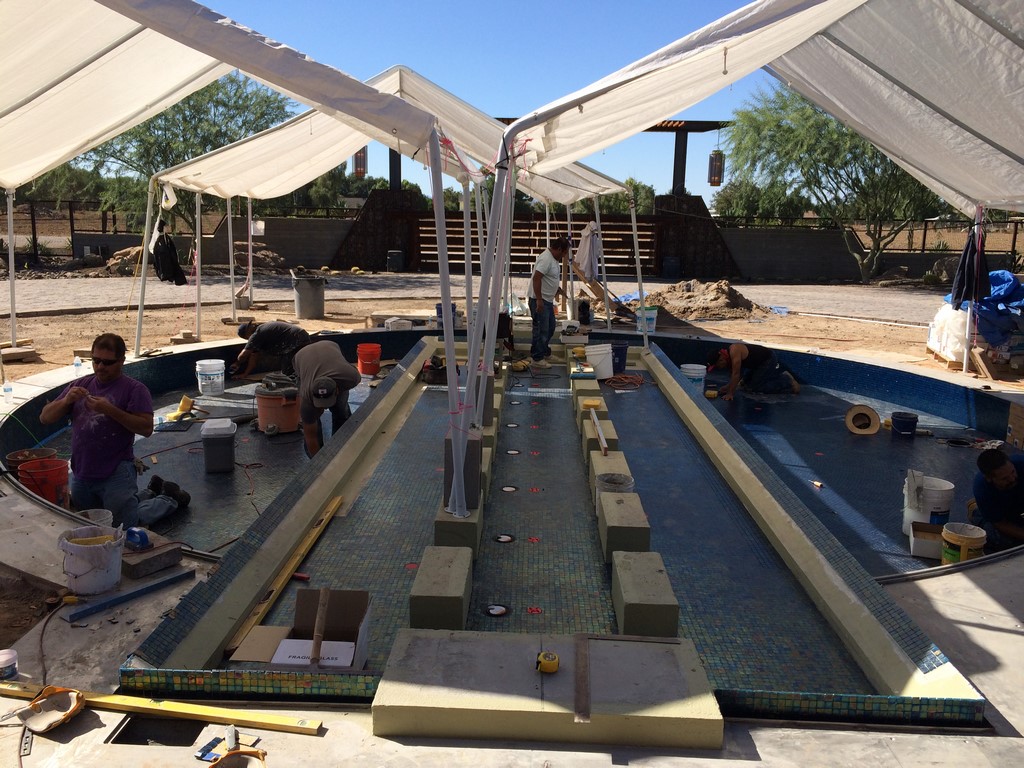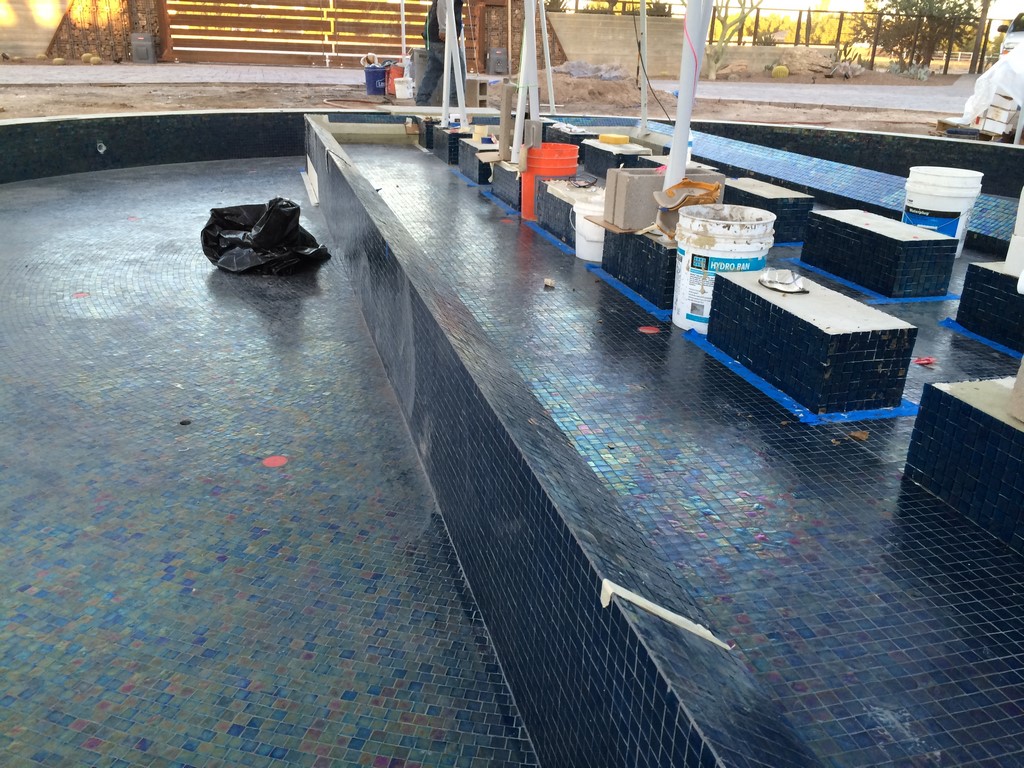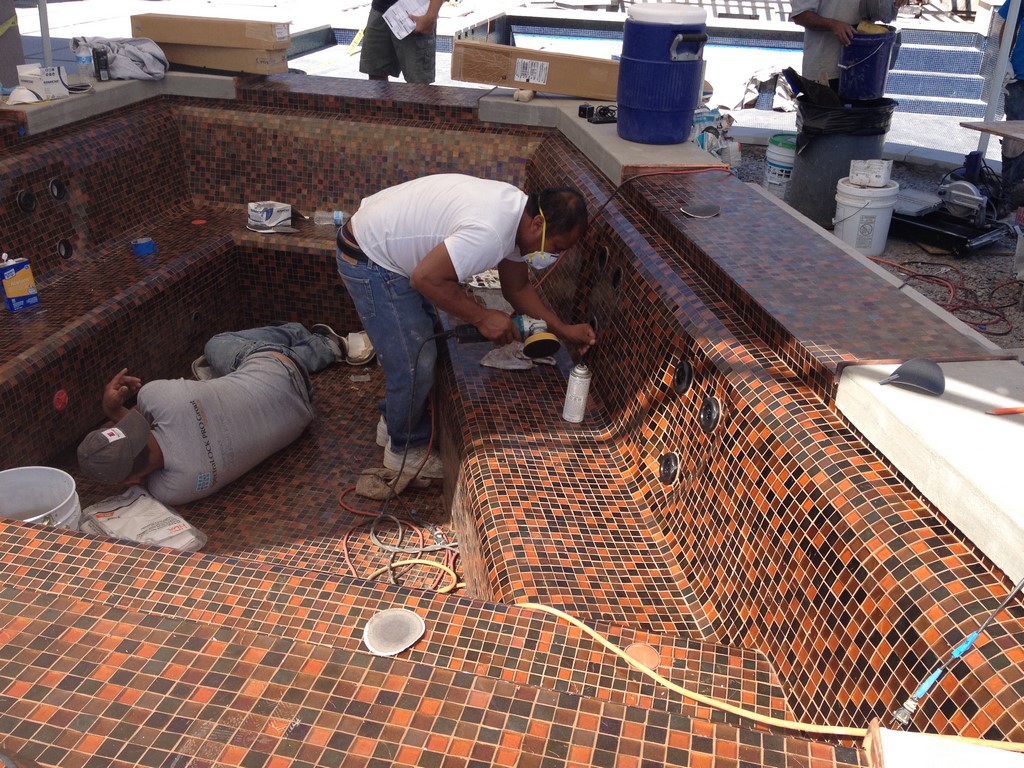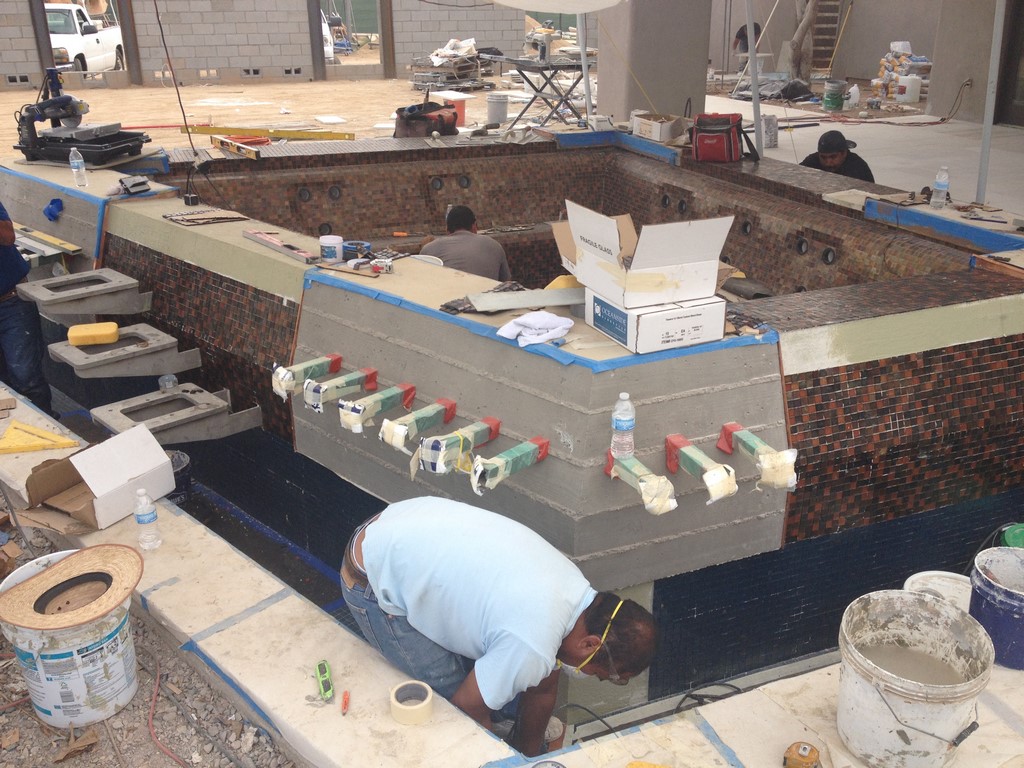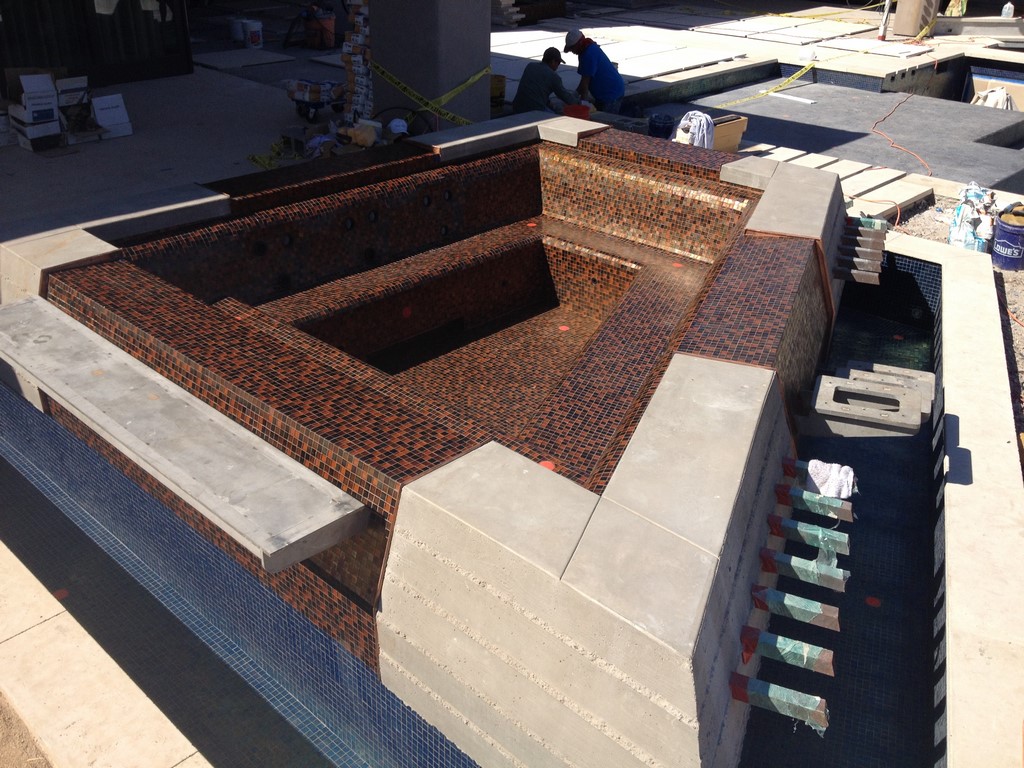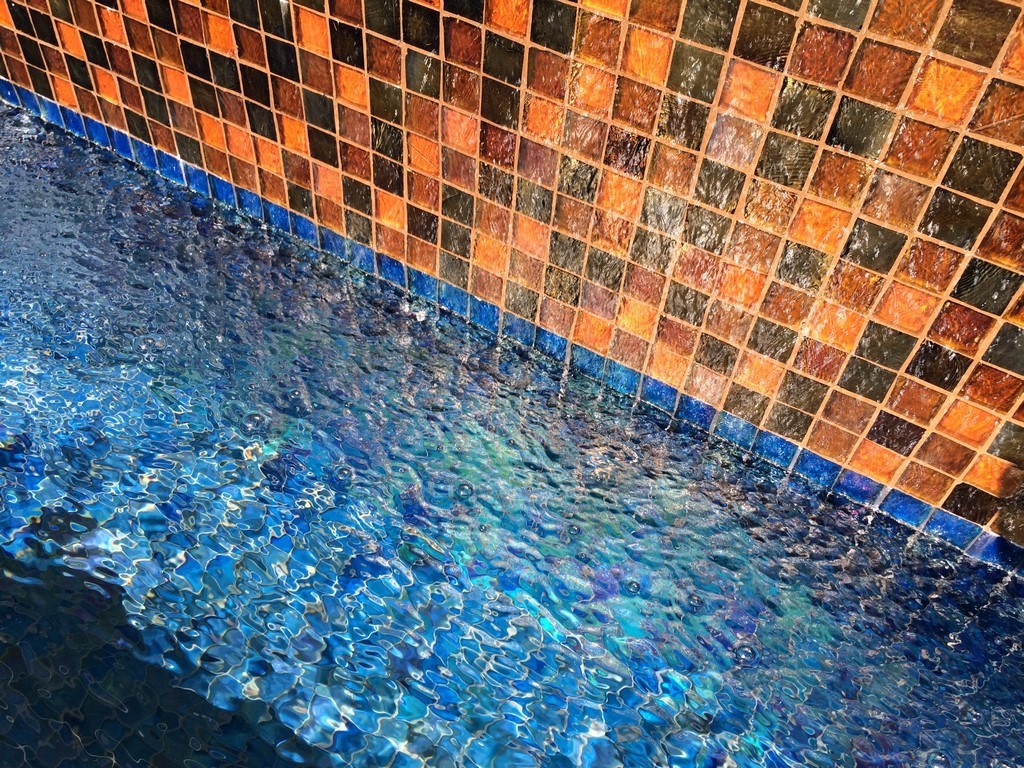Double the Pleasure
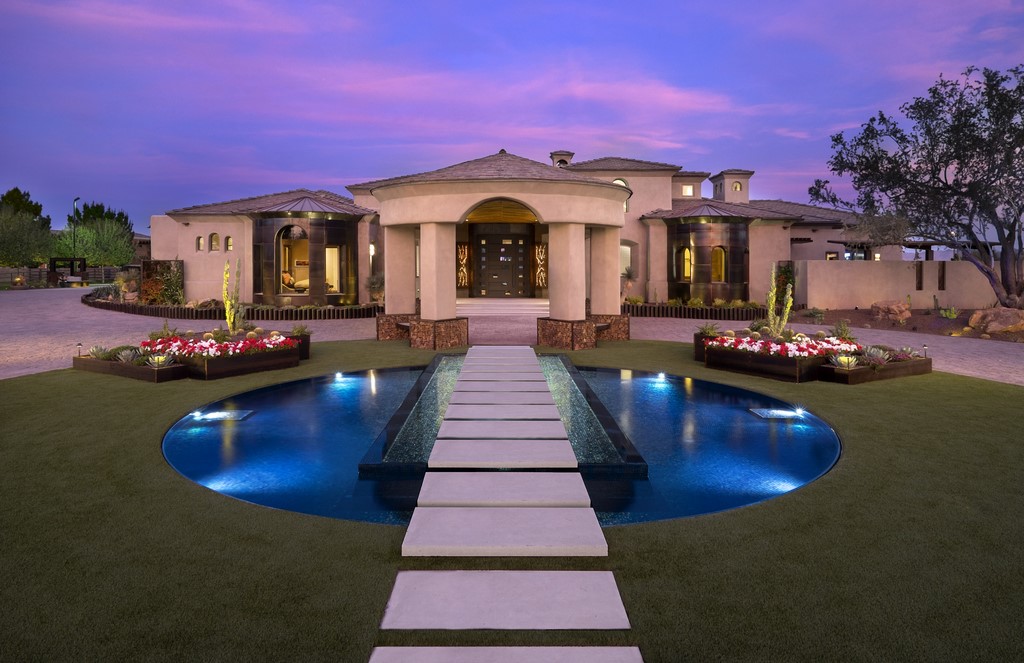
Devising an approach to the application of fields of glass tile to complex surfaces is never simple, but when your goal is to do so while minimizing cuts and eliminating any visual “tics” that might stand out like sore thumbs when the work is done? That’s taking the work to a whole different level.
The project under discussion here, built in Gilbert, Ariz., offered this sort of challenge twice – once in a large entryway waterfeature, and again in the backyard with an outsized spa. Both watershapes offered intricacies of a sort we don’t always encounter, but in both cases the focus had to be on perfection.
The key for us at Rock Solid Tile (Calabasas, Calif.) is that we never let the scale of the tasks at hand get us down: We’re methodical, thorough and vastly detail-oriented, and we know from experience that just about anything is doable if you think things through and spend adequate time preparing every square inch of the surface for tile application.
OUT FRONT
The concept for the waterfeature fronting the house was just awesome: The water was to rise to the level of the patch of grass (actually artificial turf, which made sense in the middle of the Arizona desert), and above it was to float a line of steps crossing atop a slightly raised basin in a composition that looks a bit like a giant banjo.
The design was cool and fairly simple as watershapes go, but it offered a multiplicity of straight and curving surfaces at a variety of elevations and depths that made developing a glass-tile solution about as complicated a task as we’ve ever faced.
| As watershapes go, this one is fairly simple in visual terms. But with its multiple levels, sweeping curves, numerous penetrations and high visibility, preparation of the surface for application of glass tile was a real challenge for our crew. The keys are clear communication about tasks and procedures, lots of careful double-checking and complete dedication to visual perfection without compromise. |
There was one level for the main circular basin, then another for the rectangular basin and the platforms for the stepping pads. There were cuts and angles for the perimeter-overflow systems and long, sweeping radiuses for the walls. There were large numbers of penetrations we had to accommodate for lighting and circulation systems. And everything had to be visually flawless, with cuts in the glass tile allowed only where the floor of the circular basin swept into the walls of the rectangular basin.
There’s an art to figuring all of this out in basic terms, and then an even greater degree of skill in preparing the substrate to make everything work the way we want it to. It’s never a knock on the builder or the concrete crew when we say we always have a lot to do in dealing with the irregularities we find when we start our work: Even under the best of circumstances, there’s always plentiful work involved in easing the way to a perfect tile finish.
| The completed entry space looks great and sets the tone for the experience of everything beyond these opening steps. We did all we could to prepare the space for close-up viewing, right down to making the necessary corner cuts (seen at right) align with perfect mirror symmetry. |
Sometimes we add material, other times we chip it away. In either event, we’re relentless at this stage, because we know what we do here will simplify the actual tile-setting process – and dramatically in a case such as this.
For obvious reasons, we pay special attention to the edges of perimeter-overflow or vanishing-edge systems: We work to tolerances of one thirty-second of an inch across the entire perimeter and can’t be satisfied with anything even slightly out of alignment: That sort of defect is visually devastating, so we never compromise.
Experience is important, too. We know the tile we work with, we know the waterproofing materials and mortars and grouts we use, we know about environmental conditions and the need to work within manufacturer-recommended ranges for temperature and humidity. We never take chances: These are critical applications, after all, and we want our tile surfaces to last forever.
IN THE BACK
Where the waterfeature in the front yard was a model of geometric regularity, the spa designed for the client’s backyard was pretty much the opposite: It had weird angles – lots of them – with a few unusual elevation changes thrown in for good measure.
Again, I have nothing but praise for the team at Red Rock Pools & Spas (Mesa, Ariz.): That they were able to form both of these monsters and turn them over to us in as good a shape as they did was extraordinary. But needless to say, we had our work cut out for us in making these surfaces ready for the sort of flawless tile installation we’re always pursuing.
| Tiling the backyard spa was an entirely different sort of task, with its irregular trapezoidal shape, generous rolling contours and numerous penetrations inside and out. We prepare these surfaces with meticulous, granular care, working through every detail ahead of time so that when we actually start laying tile, the process unfolds smoothly, rapidly and beautifully. |
Tile is a material that loves surfaces that are straight and plumb and preferably square or rectangular. This spa, however, was basically trapezoidal and had sloping walls and seats as well – not to mention penetrations for multiple jet arrays. (We’ve gotten to the point where we hide lighting and suction/return systems in little kickplate-style details we put at the bases of some of our walls, but there’s no getting around the need for jets in a spa.)
Spas are also places in which bathers interact with the surface to a far greater and more intimate degree than they do in a pool or, on this site, with the big entryway waterfeature. So there’s extra attention paid to rolling surfaces and removing edges that can cut or in any other way irritate someone relaxing in the water.
| It’s easy to look at glass tile as a difficult material – and there’s no doubt that it can be unforgiving. But if it’s approached with the right attitude by crews well-versed in proper preparation and application techniques, the results truly speak for themselves. |
As I’ve mentioned here and elsewhere, it’s always our ambition to lay tile without cuts. With shapes and angles like these, however, that’s a practical impossibility – but we still do everything we can to make all necessary cuts as precise as possible and to set them up in such a way that they make only a minimal impression on anyone who might be inclined to notice such a fine detail.
It helps on these occasions to have professional, well-trained crews who know what we’re after and know that they need to think about every detail as the process unfolds. They have a lot of responsibility, and they know that they’ve been hired for the Rock Solid Tile team because they think about what they’re doing, know the sorts of options they have in making things work visually and never hesitate to step back and ask questions before proceeding. Nobody likes the possibility of having to rip work apart and start over, so it all makes sense.
TWICE THE FUN
The two watershapes we worked on for this project were something of an odd couple – one formal and geometric and basically blue, the other irregular and stubborn and copper-colored – but the home set between them mediates the differences beautifully and it all comes together.
Between them, these watershapes explore the limits of what can be done with tile. It would have been far easier with both vessels to bring in the mixing rig and apply a plaster or pebble finish, and the results might have been lovely. But in both cases, the client opted for the all-tile approach, and we delivered in ways that made the choice seem natural.
We find tremendous pride and satisfaction in what we do for our clients and their watershapes. But then there’s the fact that we see projects such as these as being fun: That’s certainly a bonus.
Jimmy Reed is president of Rock Solid Tile, a tile design/installation firm based in Calabasas, Calif. He founded the company in 1985 after spending his teens and early 20s learning the tile-installation trade. In between, he attended Art Center College of Design (Pasadena, Calif.) and spent several years working in the entertainment industry. For the past 20 years, Reed has focused most of his creative energy on designing and installing tile finishes for high-end custom watershapes, a process that has seen him work with some of the industry’s leading designers and builders. He may be reached through his web site: www.rocksolidtile.com.














